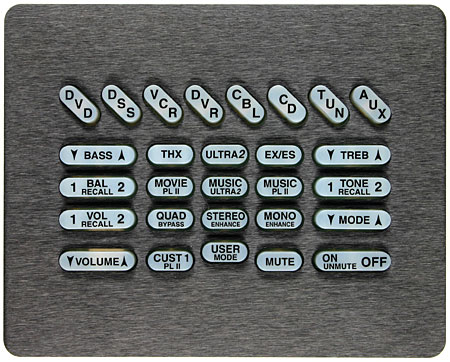Pioneer S-2EX Speaker System, ADA Cinema Rhapsody Mach III Controller, and ADA PTM-8150 Amplifier Page 2

Full Disclosure
Even without grilles, the EX speakers gave up a sliver of the immediacy that the ADA components had delivered with my reference speakers. The lower midrange was noticeably enriched, although it wasn't nasal, chesty, or honking. The overall effect was not a veiling, a dumbing down, or an across-the-board softening of detail. What I began to hear from the EX speakers, along with warmth, was smoothness, ease, authority, reliable spatial focus, and the steady disclosure of previously unknown information.
Deodato 2—an underrated album playing on an unsung system—was a revelation. Deodato, the Brazilian pop/jazz genius, hit it big in 1973 with Prelude, his first album, thanks to a rendition of "Also Sprach Zarathustra" that played off of the popularity of the use of Strauss's famous theme in 2001: A Space Odyssey. His all-but-forgotten follow-up had the same dense tapestry of percolating instrumental textures built around the leader's electric piano and recorded with the same flat restraint. But, without the brass section singing an attention-getting theme, the second album flopped, bankrupting CTI Records in the process. The whole seemed less than the sum of its parts when I heard the CD just recently for the first time.
But then the EX speakers got to work, scrupulously creating an instrumental separation I hadn't heard before. Suddenly, I could visualize the band members standing between the front speakers, tightly spaced, but each one having his own well-defined spot in the mix. The effect was even utterly unchanged when I got up and stood directly in front of the left speaker—the imaging from Pioneer's coaxial driver array was that rock solid and pinpoint precise.
I wanted to try violas. The violin's slightly lower-voiced cousin is routinely shortchanged by speaker designers, often sounding more like a muffled violin than the distinctive instrument it is. Bach's Brandenburg Concerto No. 6 is thick with massed violas, and, in the London Philharmonic recording with Sir Adrian Boult, the Pioneer/ADA system let them sing in their own distinctive voices, the system's inherent warmth giving full rein to the instruments' sweet tone. The soloist in Bartók's Viola Concerto was equally well served in the Naxos recording with Hong-Mei Xiao and the Budapest Philharmonic, emerging in the spacious recording with the bright cutting edge of a violin but the dark trajectory of a viola.
The Sound of Conflict
X-Men: The Last Stand made the PTM-8150's LEDs dance like a cowboy was shooting at their legs. Clipping was not a problem—I never heard the PTM-8150 flinch. Even when the gale-force scene that killed Patrick Stewart's character rammed the power meters into the red, I heard no alteration in tonal balance or dynamics. The vocals remained intelligible above the noise, as you'd expect with two Shakespearean actors (the other being Ian McKellen) shouting through a coaxial driver array. A brief experiment with a Lord of the Rings action sequence, running full range, revealed fearsome bass response. The sub performed well, but, with speakers and amps like these, the sub is almost an afterthought.
In keeping with the seriousness of its historical subject, the 9/11 re-enactment in United 93 calmed the frantic LEDs and changed the emphasis from brute force to low-level resolution. Starting with the eerie prayers of the attackers, the dialogue did little more than gently bump the center indicator for most of the soundtrack. The movie did its storytelling with ensemble acting, weaving a complex fabric of overlapping dialogue—both aboard the ill-fated plane and in the control towers, where many real-life participants played themselves. The S-7EX center mastered the quiet complexities of the vocal stream, keeping key elements sorted, so I never had to reverse-scan to catch dialogue.
Kingdom of Heaven decked its Crusades-era story (OK, this is not an irony-proof juxtaposition) in full soundtrack regalia, including an orchestra, chorus, drums, and the inevitable synthesizer. There were quiet moments to complement the noisy ones, such as the whisper of a forest, the murmur of a bazaar, and gulls on a beach following a shipwreck. But the story culminated in the noisy siege of Jerusalem, a series of battles notable for the sparing use of the surround channels. Most of the aural action was instead loaded into the front left, center, and right, riveting attention where it belongs, on the screen, and emphasizing the system's side-to-side panning prowess. When details did occasionally emerge in the surround channels, their heightened impact was gratifying.
Happily Wed
The Audio Design Associates components made the Pioneer EX speakers perform feats I hadn't previously noticed in two trade-show demos of the latter. And the Pioneers, supported with superior amplification, delivered loads of complex information without inducing listener fatigue—a pair of tricks seldom accomplished simultaneously. If your credit rating allows for it, this system will meet the highest standards of the most finicky home theater buff, both cinematically and musically. If you don't believe me, just listen.
* Audio editor Mark Fleischmann is also the author of the annually updated book Practical Home Theater (www.quietriverpress.com), now available in a new edition for 2007.
Highlights
Pioneer S-2EX Speaker System:
• Yes, Pioneer makes loudspeakers
• Has seemingly bombproof enclosures
• Guaranteed to be nonfatiguing
Highlights
ADA Cinema Rhapsody Mach III Controller and PTM-8150 Amplifier:
• One of the sweetest amps in the history of custom installation
• Controller exhibits both PC savvy and flashy showmanship
• Designed and built in the United States of America
- Log in or register to post comments






























































